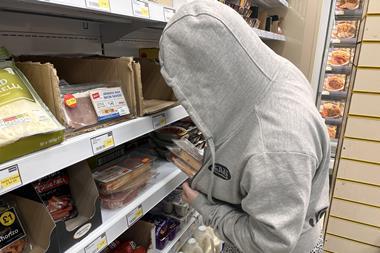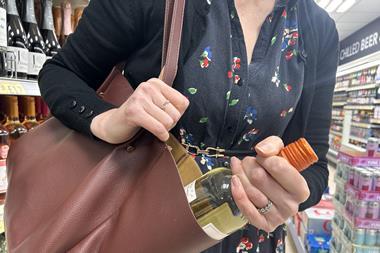Find the right supplier and bedding plants could be big business for your store
If you’ve already filled your store to the rafters, then you could be forgiven for thinking that you don’t have room for a whole new category. But leading retailers across the UK are utilising the space outside their stores to sell bedding plants, with blooming marvellous results.
Scotmid Stockbridge in Edinburgh sells bedding plants from wholesaler Raith Fruit & Flowers, which supplies fresh produce and horticultural goods. “They pick the best selection based on sales across the Scotmid stores,” says branch supervisor John Allan.
Having withdrawn from bedding plants several years ago after finding himself unable to compete with the likes of B&Q and Homebase, Paul Cheema, director of Malcolm’s Stores, has recently re-entered the market. “We started selling bedding plants again last year,” he says. “Our plants are from the horticultural market in Birmingham and we also get some from supplier JB Turner. We make 35%-plus margins.”
Rishi Madhani, who owns Today’s Stokenchurch in Buckinghamshire was initially supplied bedding plants through his flower supplier. “I started stocking bedding plants a couple of years ago after my flower supplier at the time recommended I give them a try. He told me about the category and the prices and helped me with a range,” says Rishi. “He told me how much supermarkets and DIY stores sell them for and what I could sell them for and the margins I could make, and I thought I’d give it a try.”
Floral favourites
Busy Lizzies
Busy Lizzies produce masses of flowers and can grow in both sunny and shaded areas
Petunias
Notable for their trumpet-like appearance, Petunias require at least five hours of sun a day
Lobelia
Grows in sun or part shade, suitable for pots, baskets and borders
Fuchsias
Available in pinks, reds, lilacs, whites and purples, Fuchsias grow happily in sun or semi-shade.
It was a similar story for Dean Holborn, who owns Holborn’s stores in Redhill and Nutfield in Surrey. “The people we dealt with for cut flowers said we should look at bedding plants so they put a range in for us and it got bigger and bigger,” he says.
However, both Dean and Rishi felt that they would benefit from a larger share of the profits, so they looked to alternative producers.
“We’re now buying direct from Holland,” says Rishi. “We get a delivery once or twice a week of cut flowers, bouquets and bedding plants, depending on what they have. Before, the value for money wasn’t great; we were only making about 25-30%. Now we’re making 45-50% and the plants are fresher because they haven’t been through the middle man.”
Meanwhile, Dean found a local grower who was willing to supply him directly. “Before, we were working on a 25% margin, which I felt wasn’t strong enough and we were taking a lot on any losses,” he says. “Last year we started looking at growers to cut out the middle man. I was at the National Convenience Show and got talking to David Knight, who owns two Budgens stores in West Sussex. He recommended Peter Eastwood Plants, a grower in Ditchling, West Sussex. He sells really good plants at fantastic prices so we ended up taking over the bedding plants section ourselves and buying direct.”
As a result, his margins more than doubled, and sales went up, too. “We sold way more than we had through the previous supplier because we had confidence to stock more. We now have a 60% margin because we’re buying right.”
One Stop retailer Sunder Sandher has sold bedding plants from his Leamington Spa store in Warwickshire for the past 30 years and has built up relationships with several local growers. “I get my plants from local nurseries and a company who imports from Holland,” he says. “There’s great profit in bedding plants – I make a 50% margin.”
Of course, bedding plants can’t be sold all year. “We start selling bedding plants in March once the colder weather has passed,” explains John. “You can’t put plants out too early because of the risk of late frost killing them off,” adds Dean. “We start stocking plants from Whit Sunday; people are back in their gardens by then and you have a good run at it until June or July, by which time gardens are in bloom anyway.”
There are several things to take into account when selling plants outside your store – not least of all is ensuring your local district council gives you permission to use the space.
Then there is caring for the plants. Susie Hawkins, director of family-owned Simon Smith Group, owns seven forecourts under the Budgens and Spar symbol groups in and around Gloucestershire. She claims that selling bedding plants requires care and attention. “You often get a cage of them and so must rotate the plants so they all get air and light,” she says. “You can’t leave them out in the cold weather. And if you have a canopy you have to bear in mind they’ll never get rain, so you have to water them well, but equally you don’t want plants in the blazing sun as no one will want them when they’re in full bloom.”
Looking after plants
Dean agrees that plants require care and attention. “It’s hard work; you’ve got to look after them. They need watering and deadheading every day.” However, he advises retailers to see if anyone in their team has green fingers. “If you look at your staff, you’ll probably find someone who’s a keen gardener and you can give them responsibility for the area. My brother is keen on plants so he looks after them in our business.”
When it comes to display, Susie claims that plants only sell well if you have a plentiful display. “You have to stock lots in order to sell them. If you want people to buy them it’s no good having two dead plants tucked away in the corner. You have to make them visible.”
Sunder has all his plants displayed on trolleys outside the shop. “We have five or six trolleys full of plants, I just blitz it! We’ll have five or six people browsing them and then other people driving by will stop.”
Placing them outside your store is a sure-fire way to ensure that everyone knows you stock plants. But it also sends a positive message to customers. “It dresses the store having them on display,” says Dean.
Rishi agrees. “I put all the plants on upside- down wooden crates for display purposes. If the outside of the store is inviting with bright, fresh plants and flowers it sets the standard for your store,” he says.
But even with the best will in the world, you’re never going to sell everything. Paul claims that wastage is part and parcel of stocking plants. “You get wastage throughout fresh products,” he says. “You just have to build it into your model.”
Rishi supports Paul’s theory. “A lot of people are scared to throw away bad plants or flowers, but if they’re getting old then reduce them and get rid of them.”
And the results speak for themselves. “It’s a profitable business. When it’s busy I sell £350- to £400-worth a week,” he says.
Dean has also witnessed strong sales. “We had the most amazing season last year. We’re surrounded by fab garden centres, but we found people would graze the area, and pick up two or three plants.
“They’ll plant a few bits and then buy more next time they come in. You get the odd person who buys a load in one go, too. Last year we hit sales of more than £600 a week. One week we sold £800 at the Redhill store.”
Sunder boasts fantastic sales, too. “We sell £1,000-£2,000 a week,” he says. “I kill all the local competition. If a plant is selling at £5.99 in a nursery, we’re selling it at £2.99 and it cost us £1.50.”
Your flower supplier may well be able to help you get started with bedding plants if you are looking to test the water. But if you’re ready to take the next step and buy direct from a market or grower, then don’t be afraid to ask questions. “At the market you have to look for the right supplier who isn’t going to rip you off,” says Paul. “Never be afraid to ask for help and talk to other retailers – I just talk to people I bump into at the market.”
He claims that local markets can be a good way to make contacts. “The best way to get started is to go to a local market and have a chat with the sellers and see if they’ll deliver plants direct to your store.”
Rishi even suggests buying with another retailer. “Even if you can’t meet minimum order requirements, you can always talk to the retailer down the road and then split the order between you,” he suggests. “I think anyone could make a go of it.”
Sunder is equally as passionate about selling plants. “It’s a good product to get into and once you get a reputation for bedding plants people will come from far afield to buy them,” he says.
“I’d recommend any retailer with a bit of space outside their store to look into it. Try it and you’ll be surprised.”
Paul urges his fellow retailers to give bedding plants a try. “Anyone can make it work, whatever size your store is,” he says. “The space outside your store is valuable, so use it.”
Expertise in fresh means plants are a good fit
Peter Eastwood Plants supplies several c-stores, including Knight’s Budgens of Hassocks, West Sussex, and Holborn’s in Redhill and Nutfield, Surrey, and director Adam Eastwood is convinced that bedding plants are a big opportunity for the convenience channel.
“There’s a lot of potential to sell plants out of local stores,” he says. “C-stores are already well equipped for fresh produce and are used to monitoring quality and managing wastage.”
He claims that volume sales are where the money is. “You need to push through a reasonable volume and the tricky thing is knowing how much you can sell. The key is finding a supply chain that works.
“We have a minimum order requirement because we’re tailored for garden centres, but there are companies who buy from us and supply smaller stores. There’s room in the mark-up for that as the price that people are used to paying for bedding plants covers all the overheads for a garden centre.”
Adam uses his expertise to provide customers with top-selling products. “The range I supply to c-stores is always changing, but it’s one line at one price – eg 20 trays of plants – and we pick whatever is in season and looks good. Retailers then offer them at four for £10.”






















No comments yet